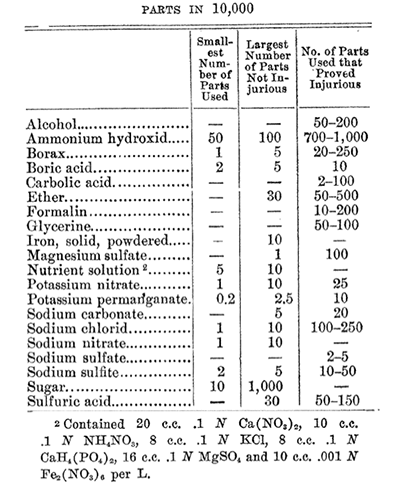Experimental efforts to retain the freshness in cut rose blooms.
Pember, F. R.. "Experimental efforts to retain the freshness in cut rose
blooms." Science 40, no. 1024
(August 14, 1914): 248.
[https://library-projects.providence.edu/rosarium/view?docId=tei/rg0118.xml]

During the spring of 1908 the Rhode Island Station had a large surplus of rose blooms from its experimental beds, and at the suggestion of Dr. H. J. Wheeler, who was then director of the station, the writer carried on over one hundred and fifty tests with solutions of various kinds of chemicals and in various concentrations, to ascertain their effect in promoting the keeping qualities of the cut blooms, whereby the average housewife could with slight trouble and expense prolong materially the period of freshness of the blooms; thus increasing largely the usefulness of the rose as a home decoration.
Most of the tests were made in May, 1908, while the final tests were completed in July, 1913.
The varieties of rose blooms used in 1908 were Brides and Bridesmaids, while the Maryland was used in 1913.
In most cases the blooms were taken immediately after being cut, and divided into uniform groups of six to eight. The stems were cut from 7 to 10 inches long, and placed in wide-mouthed flasks of 500 c.c. capacity. Ordinary water was used as the solvent in all of the tests, and a control flask was included with each lot of blooms, all of which were kept under laboratory conditions and in the original solutions for periods of from four to seven days. The number of tests of a given concentration of a chemical varied from one with the extremes to as high as three or four with some of the medium dilutions.
In the following table the degrees of concentration of the solutions are divided into the lowest used, the highest used which was not injurious, and those used which proved injurious.
A mixture of one part of carbolic acid and three parts ammonium hydroxid in 10,000 did not prove injurious, while two parts carbolic acid and 50 parts ammonium hydroxid did prove injurious.
Of all the tests, a strong sugar solution, 7-10 per cent., was the only one that caused any marked freshening in the appearance of the blooms. This effect was shown by a deepening of the color of the pink varieties within a few hours after the stems were placed in the sugar solution, whereas those in water faded much sooner. However, the breaking down of the blooms and the dropping of their petals occurred at the same time in the flasks containing sugar as in those containing only water.
When clean flasks were used, the changing of the water daily, or the cutting off of the end of the stems and changing the water daily did not prolong the keeping qualities of the blooms.
F. R. Pember
Rhode Island Experiment Station

